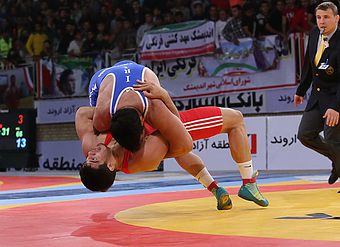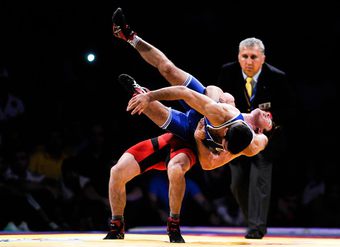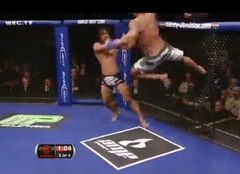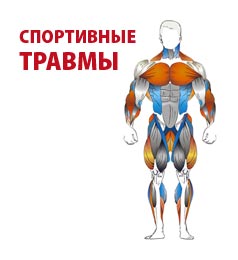Origin and development of national wrestling kurash
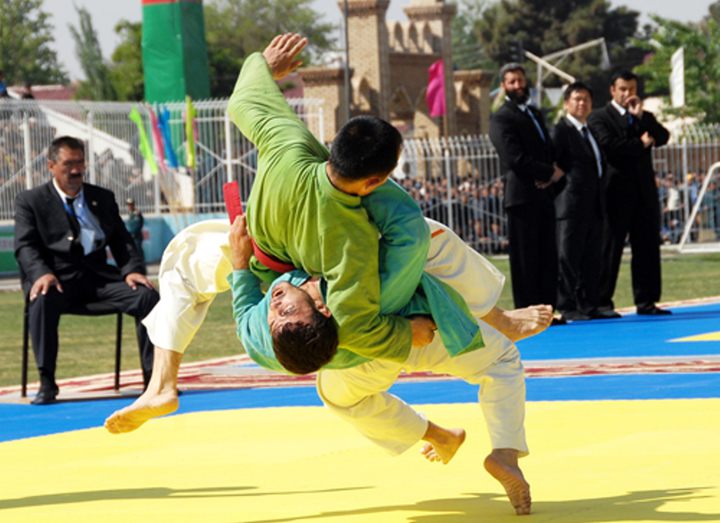
Wrestling is one of the most ancient, generally available and widespread national sports. The success of school of wrestling (classical, free, sambo and judo) in many respects is defined by that almost in all republics national types of wrestling are widely developed: Uzbek wrestling (kurash), Georgian wrestling (chadaoba), Kyrgyz (kures), Moldavian (trinte) and many others. Their more than 40.
In Uzbekistan exists two different in the technical and tactical receptions, types of wrestling sharply differing from each other kurash. Division this historical also has the territorial boundaries, namely – national wrestling by Bukhara rules is widespread in Karakalpakstan, Bukhara, Dzhizak, Samarkand areas. Methods of wrestling by the Fergana rules act on the territory of the Tashkent, Syr-Darya, Surkhan-Darya, Fergana, Namangan and Andizhan areas.
Wrestling kurash arose in an extreme antiquity. The ancient Roman writer Elian has data that in a tribe of juice competitions were very widespread on the wrestling, become a favourite folk custom. Under its certificate, the young man from a tribe of juice acquired the right to marry the girl only under a condition if he won against her wrestling. Some archeological finds as say that competition on wrestling was one of folk customs of ancestors of Uzbeks. For example, in case of excavation of fortress of Dzhanbas-kal (the 17th century BC), its clear split into two parts was revealed. Professor S. P. Tolstoy reads this structure of the city the existence proof in it two types of a national community. There was a custom wrestling between citizens which had ritual character and was carried out in day of celebration of new year (Navruz).
From ancient chronicles it is known that in Fergana traditional ritual wrestling was carried out to a New Year's holiday between two parts of the city, each of which exposed the wrestlers.
In case of archeological excavations the figures of wrestlers figuring the moment of wrestling are found. For example, on a glass for the wine, found in Koy-Kyrylgankale (the 4-3rd eyelid BC), the man's figure in a pose of the fist wrestler is figured. In records of the Greek historian Pompey Troga (the 1st century BC) the ancient tribes occupying once the territory of the modern Uzbekistan which were skillful wrestlers, are mentioned by fist wrestlers, equestrians shooters, javelin throwers, archers, i.e. owned martial arts.
The historian, the ethnographer and the linguist Mahmoud Kashgary in the known work "Meeting of Turkic Literature" writes about fights wrestlers which, having undertaken belts, bent to the opponent a neck and achieved a victory in duels, applying speed and dexterity of feet.
Navruz's celebration in the capital of ancient Sogdiana - Samarkand was always accompanied by national festivals on which representatives of folk art (bahshi, storytellers, musicians, rope-walkers) appeared. In such festivals the people with a great interest watched speeches of rope-walkers, saltuses. Mandatory, almost ritual show of every holiday was national wrestling kurash. Annually as a result of competitions one of kurashist was entitled wrestler Sogdiana. On festivals he sat in a place of honor and caused on single combat of anyone.
Before battles of armies each conflicting side exposed from the army of the strongest wrestler. They could battle a sword, a spear, onions or an arrow. If wrestling had no prompt outcome, and all tools of wrestling became useless, hand-to-hand wrestling during which one of rivals aimed to pull down another from a horse began and to crush it. The army which representative I was won wrestler, read itself won. Speak: "And one in the field soldier". To understand this aphorism, it is necessary to glance deep into stories when the conflicts between the states and tribes were solved in a duel of their strongest representatives. This ritual or tradition of guiding of military operations in ancient Sogdiana prevented bloodshed.
Echoes of this ancient custom is reception "ogdarysh" (a scontraction from a horse), used in horse competitions. If none of opponents after a contraction from a horse didn't perish, wrestling proceeded in the form of competition in force on belts. The victory was adjudged to the one who achieved death of the rival and consequently also victories to the army.
Fifths Kurzi Ruff (the Greek historian) writes that Alexander of Macedon's armies in case of a gain of Central Asia captured once 30 athletes. Knowing that they are expected by death, they behaved courageously - sang, danced, expressing the neglect to death. Alexander of Macedon saved life to these people, having estimated their firmness and courage.
The legend which has a historical basis remained. When Arabs approached to Samarkand and punched a fortress wall, the wall had an athlete who long time could resist to the Arab army and didn't let them to the city. His name didn't remain in the history, but it is known that only one sword it exterminated about one thousand enemies, but as a result fell in unequal wrestling.
Apparently, since ancient times national athletes – wrestlers, differed big physical force and endurance, courage and nobility. They rose in defense of the Homeland, defended justice. About national heroes we learn a lot of things from past literature. For example, in the poem "Shakhnama" of Firdausi glorifies national athletes and urges the people to wrestling against overseas aggressors.
In the history and memories of the people are stored names and feats wrestlers the past and the present. The Arab conquerors imposed the prohibition of development of military science and sports at the people of Central Asia, however art of equestrians and wrestlers continued to develop. The Arab geographer of the 10th eyelid Madisi reported that in Samarkand, Balkhe, Kurgan in days of a sacred holiday of Kurban Bairam was permanently carried out wrestling which attracted more number of the audience.
Valuable data on national wrestling kurash contain in the Uzbek folklore. From works of this genre we learn not only about the fact of existence kurash, but also about its features, conditions and technique of wrestling. Sporting national wrestling is reflected and in fairy tales. For example, in the known fairy tale "Hassan and Zukhra"." Month for months, year after year - there passed 7 years. Hassan and Zukhra grew up. Hassan began to struggle with children once, and all boys in a kishlak overcame. And the further Hassan grew, the he became stronger. I began also adults in wrestling to overcome. Hassan the slender Dzhigit grew up and people "Hassan athlete" nicknamed him. In the fairy tale "Tulganoy" the fighting episode is described. Armies of the kagansky khan went war on Ur-Tyube. When kagansky N uratyubinsky armies met, they were built against each other. Kagansky athletes left forward and caused on a duel wrestlers uratyubinets. The call was accepted by the uratyubinsky athlete Alannazar and the kaganskikh of wrestlers won. This episode says that wrestling duels were means not only victories over the opponent, but also made moral impact on them.
Judging by these fairy tales in wrestling started being engaged since the early childhood that having reached youth, to become the skilled wrestler, capable to bear military service or to appear in sports meets for the tribe or later the city.







